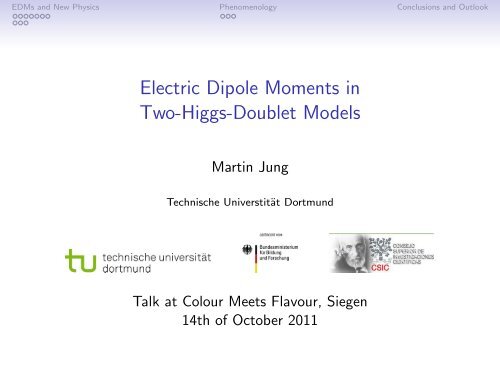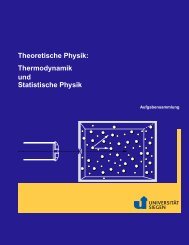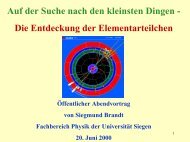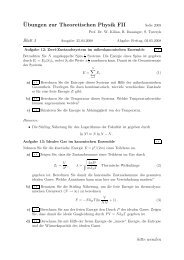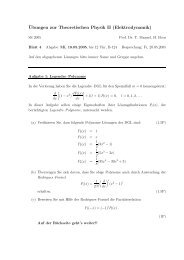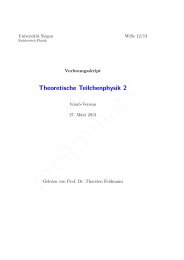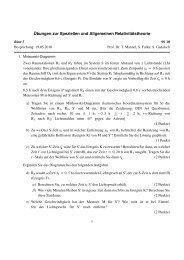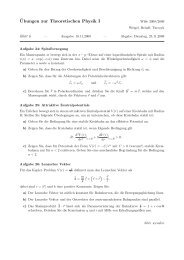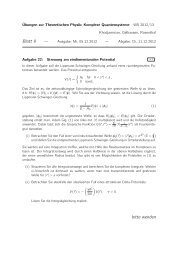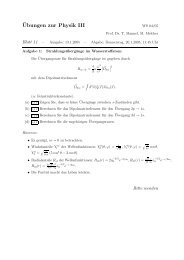Electric Dipole Moments in Two-Higgs-Doublet Models
Electric Dipole Moments in Two-Higgs-Doublet Models
Electric Dipole Moments in Two-Higgs-Doublet Models
Create successful ePaper yourself
Turn your PDF publications into a flip-book with our unique Google optimized e-Paper software.
EDMs and New Physics Phenomenology Conclusions and Outlook<br />
<strong>Electric</strong> <strong>Dipole</strong> <strong>Moments</strong> <strong>in</strong><br />
<strong>Two</strong>-<strong>Higgs</strong>-<strong>Doublet</strong> <strong>Models</strong><br />
Mart<strong>in</strong> Jung<br />
Technische Universtität Dortmund<br />
Talk at Colour Meets Flavour, Siegen<br />
14th of October 2011
EDMs and New Physics Phenomenology Conclusions and Outlook<br />
Outl<strong>in</strong>e<br />
EDMs and New Physics<br />
Importance of EDMs<br />
<strong>Two</strong>-<strong>Higgs</strong>-<strong>Doublet</strong> <strong>Models</strong><br />
Phenomenology<br />
EDMs <strong>in</strong> 2HDMs<br />
Conclusions and Outlook
EDMs and New Physics Phenomenology Conclusions and Outlook<br />
Importance of EDMs<br />
Flavour-sector of the SM is special (→):<br />
• Unique connection between Flavourand<br />
CP-violation<br />
• FCNCs highly suppressed<br />
• FConserv<strong>in</strong>gNCs with CPV as well!<br />
d SM,CKM<br />
n 10 −32 e cm (Pospelov/Ritz ’05), well below<br />
foreseeable tests<br />
EDMs test sources for CPV to extremely high precision:<br />
• Experimentally e.g. d exp<br />
n 3 × 10 −26 e cm (Baker et al. ’06)<br />
Strong CP problem; below some dynamical solution assumed<br />
Background-free precision-laboratory for NP!
EDMs and New Physics Phenomenology Conclusions and Outlook<br />
EDMs and NP<br />
NP models necessarily <strong>in</strong>volve new sources of CPV:<br />
• Generally (too) large EDMs (“NP models predict EDMs just<br />
below the present limits” always true)<br />
• Limits on FCNCs and EDMs imply highly non-trivial flavourand<br />
CPV-structure<br />
Generic one-loop contributions excluded<br />
(→ SUSY CP-problem)<br />
Sensitivity to two-loop contributions → UV-completion<br />
EDMs important on two levels:<br />
• “Smok<strong>in</strong>g-Gun-level”: Visible EDMs prove for NP<br />
• Quantitative level: Sett<strong>in</strong>g limits/determ<strong>in</strong><strong>in</strong>g parameters<br />
Theory uncerta<strong>in</strong>ties are important!
EDMs and New Physics Phenomenology Conclusions and Outlook<br />
Flavour meets Colour<br />
• Most str<strong>in</strong>gent constra<strong>in</strong>ts stem from neutron and atoms<br />
QCD essential<br />
• Limits usually displayed as allowed regions<br />
Conservative uncerta<strong>in</strong>ty-estimates important<br />
Atomic level<br />
⇓<br />
Nuclear Level<br />
⇓<br />
QCD level<br />
⇓<br />
Effective Theory with (C)EDMs of fermions, O W ,. . .<br />
⇓<br />
Parameters of your favourite NP model<br />
Each step might <strong>in</strong>volve uncerta<strong>in</strong>ties of orders of magnitude!
EDMs and New Physics Phenomenology Conclusions and Outlook<br />
f =u,d,e<br />
Framework<br />
Effective Lagrangian at a hadronic scale:<br />
L = −<br />
∑ [ d<br />
γ<br />
f<br />
2 Oγ f<br />
+ d f<br />
C ]<br />
2 OC f + C W O W + ∑<br />
<strong>in</strong> the operator basis<br />
i,j=(q,l)<br />
C ij O 4f<br />
ij ,<br />
O γ f<br />
= ie ¯ψ f F µν σ µν γ 5 ψ f , O C f = ig s ¯ψ f G µν σ µν γ 5 ψ f ,<br />
O W = + 1 3 f abc G a µν ˜G νβ,b G µ,c<br />
β<br />
, O 4f<br />
ij = ( ¯ψ i ψ i )( ¯ψ j iγ 5 ψ j )<br />
Options for matrix elements:<br />
• Naive dimensional analysis (Georgi/Manohar ’84): a.o. arbitrary<br />
factos of 4π (e.g. Bigi/Uraltsev ’91)<br />
• Baryon χPT : not applicable for all the operators<br />
• QCD sum rules: used here (Pospelov et al.), uncerta<strong>in</strong>ties large<br />
• Ideas, anyone?
EDMs and New Physics Phenomenology Conclusions and Outlook<br />
Theory uncerta<strong>in</strong>ties I<br />
Example: The electron EDM<br />
• Often extracted us<strong>in</strong>g d Tl = C e d e with C e = −585<br />
(Mårtensson-Pendrill, Öster 1987)<br />
• Calculations span C e ∈ [−1041, −179](!) (cancellations)<br />
• Recent results: d Tl ∼ −582(20)d e and ∼ 466(10)d e<br />
(Dzuba/Flambaum ’09, Nataraj et al.’10)<br />
• Furthermore: Four-fermion operators relevant<br />
d Tl = −(529 ± 73)d e − (34 ± 10) GeV e C S<br />
• To obta<strong>in</strong> limit: constra<strong>in</strong>t/assumption needed for C S !
EDMs and New Physics Phenomenology Conclusions and Outlook<br />
Theory uncerta<strong>in</strong>ties II<br />
Example: The EDM of Mercury<br />
• The most precise EDM-limit so far: |d Hg | ≤ 3.1 × 10 −29 e cm<br />
(Griffith et al. ’09)<br />
• However: diamagnetic system<br />
• Shield<strong>in</strong>g efficient → sensitivity ∼ d n , d Tl<br />
• All stages enter:<br />
d Hg<br />
Atomic<br />
= d Hg (S, C S,P ) Nuclear<br />
= d Hg (˜g πNN , C S,P )<br />
QCD<br />
= d Hg (d C f , C qq ′, C S,P )<br />
• Uncerta<strong>in</strong>ties:<br />
Atomic∼ 30%, Nuclear∼ x00%, QCD sum rules∼ 100 − 200%<br />
Constra<strong>in</strong>t on CEDMs not very reliable (1 CV → 1/30 rc → 0 c )<br />
Progress <strong>in</strong> theory needed to fully exploit<br />
precision measurements of EDMs
EDMs and New Physics Phenomenology Conclusions and Outlook<br />
A model-<strong>in</strong>dependent limit on the electron EDM<br />
In general: Too many parameters for model-<strong>in</strong>dependent analysis<br />
Bounds usually obta<strong>in</strong>ed by assum<strong>in</strong>g vanish<strong>in</strong>g cancellations<br />
Electron EDM:<br />
• Bound <strong>in</strong> (Regan et al. ’02): |d e | ≤ 1.6 × 10 −27 (90% CL)<br />
• <strong>Two</strong> shortcom<strong>in</strong>gs: C e = −585 chosen and C S ignored<br />
• First issue addressed already<br />
• Idea for C S : make assumption on a sub-lead<strong>in</strong>g level<br />
1. Use bound on C S from Mercury<br />
2. Use that bound and range for C e to obta<strong>in</strong> limit on d e<br />
• This procedure results <strong>in</strong><br />
|C S | ≤ 2.2 × 10 −13 GeV −2 and<br />
|d e | ≤ 2.8 × 10 −27 e cm (95% CL)<br />
• Robust, model-<strong>in</strong>dependent limt, can be used for NP-bounds
EDMs and New Physics Phenomenology Conclusions and Outlook<br />
Why 2HDM?<br />
Model-<strong>in</strong>dependent analysis: Too many parameters <strong>in</strong> general<br />
Electroweak symmetry break<strong>in</strong>g mechanism unknown yet:<br />
• 1HDM m<strong>in</strong>imal and elegant, but unlikely (SUSY,GUTs,. . . )<br />
• 2HDM “next-to-m<strong>in</strong>imal”:<br />
• ρ-parameter “implies” doublets<br />
• low-energy limit of more complete NP models<br />
Model-<strong>in</strong>dependent element<br />
• simple structure, but <strong>in</strong>terest<strong>in</strong>g phenomenology<br />
• important effects <strong>in</strong> flavour observables
EDMs and New Physics Phenomenology Conclusions and Outlook<br />
General 2HDM:<br />
Lots of 2HDMs. . .<br />
−L q Y<br />
= ¯Q ′ L (Γ 1φ 1 + Γ 2 φ 2 ) d ′ R + ¯Q ′ L (∆ 1 ˜φ 1 + ∆ 2 ˜φ2 ) u ′ R + h.c.<br />
Γ i , ∆ i : Independent 3 × 3 coupl<strong>in</strong>g matrices<br />
Flavour problem: generic coupl<strong>in</strong>gs imply huge NP scale<br />
Some of the many approaches:<br />
• Z 2 (SUSY-motivated, 1 flavour-parameter, no CPV)<br />
• Type III: Y ′<br />
ij ∼ √<br />
mi m j<br />
v 2 (Cheng/Sher ’87)<br />
• 2HDM with MFV (D’Ambrosio et al. ’02):<br />
• EFT framework, unknown coupl<strong>in</strong>gs<br />
• Yukawas rema<strong>in</strong> only source of flavour and CP violation<br />
• Expansion around Type II (as ’02 as well) with phases and<br />
decoupl<strong>in</strong>g (Buras et al. ’10). See also (Paradisi/Straub, Kagan et<br />
al., Botella et al., Feldmann/MJ/Mannel, Colangelo et al., all ’09)<br />
• BGL models (Branco et al. ’96), (Ferreira/Silva ’10), . . .
EDMs and New Physics Phenomenology Conclusions and Outlook<br />
The Aligned two-<strong>Higgs</strong>-doublet model<br />
Alignment condition: Γ 2 = ξ d e −iθ Γ 1 , ∆ 2 = ξ ∗ u e iθ ∆ 1<br />
leads to [Pich/Tuzón ’09]<br />
√<br />
−L q 2<br />
Y ,H<br />
= ± v<br />
H+ (x)ū(x) [ ς d VM d P R − ς u M uV † ]<br />
P L d(x) + h.c.<br />
with complex, observable parameters ς u,d,l , imply<strong>in</strong>g:<br />
• No FCNCs at tree-level<br />
• New sources for CP violation<br />
• Only three complex new parameters (unlike Type III)<br />
• Z 2 models recovered for special values of ς<br />
i ′ s<br />
• Radiative corrections symmetry-protected, of MFV-type (Cvetic<br />
et al. ’98, Braeun<strong>in</strong>ger et al. ’10, MJ/Pich/Tuzón ’10)<br />
• Proposals towards UV-completion (Medeiros Varzielas’11, Serôdio’11)<br />
• 1st term <strong>in</strong> spurion formalism with flavour-bl<strong>in</strong>d phases, w/o<br />
series around type II
EDMs and New Physics Phenomenology Conclusions and Outlook<br />
EDMs <strong>in</strong> 2HDMs<br />
In A2HDM, and most models with effective flavour-suppression:<br />
• One-loop (C)EDMs: controlled (not t<strong>in</strong>y) (e.g. Buras et al. ’10)<br />
• 4-quark operators: small, no tan β 3 -enhancement<br />
<strong>Two</strong>-loop graphs dom<strong>in</strong>ant (We<strong>in</strong>berg ’89, Dicus ’90, Barr/Zee ’90,<br />
Gunion/Wyler ’90)<br />
Aga<strong>in</strong> sensitivity to UV-completion<br />
• Largest charged <strong>Higgs</strong> contribution from We<strong>in</strong>berg diagram<br />
• Barr-Zee(-like) diagrams dom<strong>in</strong>ate neutral <strong>Higgs</strong> exchange<br />
• For neutrals: sum <strong>in</strong>cludes cancellations <strong>in</strong> general
EDMs and New Physics Phenomenology Conclusions and Outlook<br />
Charged <strong>Higgs</strong> <strong>in</strong> the neutron EDM<br />
• <strong>Two</strong>-step match<strong>in</strong>g (Braaten et al., Boyd et al. ’90):<br />
b-CEDM at µ EW → O W at µ b<br />
Absence of strong RGE-suppression for O W<br />
• QCD sum rule estimate for matrix element<br />
|d n | ∼ dn<br />
exp 500 GeV<br />
|Im[ζ d ζ<br />
M<br />
u]|<br />
∗<br />
H ±<br />
From BR(b → sγ) <strong>in</strong> complex ζ d ζ ∗ u-plane:<br />
15<br />
10<br />
5<br />
ImΖuΖ d<br />
⋆ <br />
0<br />
5<br />
10<br />
15<br />
5 0 5 10 15 20 25<br />
ReΖuΖ d ⋆
EDMs and New Physics Phenomenology Conclusions and Outlook<br />
Charged <strong>Higgs</strong> <strong>in</strong> the neutron EDM<br />
• <strong>Two</strong>-step match<strong>in</strong>g (Braaten et al., Boyd et al. ’90):<br />
b-CEDM at µ EW → O W at µ b<br />
Absence of strong RGE-suppression for O W<br />
• QCD sum rule estimate for matrix element<br />
|d n | ∼ dn<br />
exp 500 GeV<br />
|Im[ζ d ζ<br />
M<br />
u]|<br />
∗<br />
H ±<br />
Constra<strong>in</strong>t from neutron EDM on charged <strong>Higgs</strong> contribution:<br />
15<br />
10<br />
5<br />
ImΖuΖ d<br />
⋆ <br />
0<br />
5<br />
10<br />
15<br />
5 0 5 10 15 20 25<br />
ReΖuΖ d ⋆
EDMs and New Physics Phenomenology Conclusions and Outlook<br />
Charged <strong>Higgs</strong> <strong>in</strong> the neutron EDM<br />
• <strong>Two</strong>-step match<strong>in</strong>g (Braaten et al., Boyd et al. ’90):<br />
b-CEDM at µ EW → O W at µ b<br />
Absence of strong RGE-suppression for O W<br />
• QCD sum rule estimate for matrix element<br />
|d n | ∼ dn<br />
exp 500 GeV<br />
|Im[ζ d ζ<br />
M<br />
u]|<br />
∗<br />
H ±<br />
Comb<strong>in</strong>ation of BR(b → sγ) and neutron EDM:<br />
1.5<br />
ImΖuΖ d<br />
⋆ <br />
1.0<br />
0.5<br />
0.0<br />
0.5<br />
1.0<br />
1.5<br />
5 0 5 10 15 20 25<br />
ReΖuΖ d ⋆ <br />
orange: M H ± = 500 GeV<br />
brown: M H ± = 80 GeV<br />
Im(ζ d ζ ∗ u) strongly<br />
constra<strong>in</strong>ed, but not t<strong>in</strong>y
EDMs and New Physics Phenomenology Conclusions and Outlook<br />
Neutral <strong>Higgs</strong> <strong>in</strong> EDMs<br />
• Effect dom<strong>in</strong>ated by Barr-Zee(-like) diagrams<br />
• Non-trivial constra<strong>in</strong>ts for all comb<strong>in</strong>ations apart from Im(y 2 u )<br />
• Here: only results for Thallium, one neutral <strong>Higgs</strong><br />
Paramagnetic atom, EDM dom<strong>in</strong>ated by d e (as shown)<br />
2.0<br />
200<br />
1.5<br />
150<br />
ReylImyu<br />
1.0<br />
Imy l<br />
2 <br />
100<br />
0.5<br />
50<br />
0.0<br />
100 200 300 400 500<br />
0<br />
100 200 300 400 500<br />
MH0 GeV<br />
MH0 GeV<br />
Aga<strong>in</strong> O(1) imag<strong>in</strong>ary parts rema<strong>in</strong> allowed<br />
The A2HDM passes the EDM-test
EDMs and New Physics Phenomenology Conclusions and Outlook<br />
Conclusions and outlook<br />
Conclusions:<br />
• CPV-sector of NP models uniquely constra<strong>in</strong>ed by EDMs<br />
• Quantitative results require close look at theory uncerta<strong>in</strong>ties<br />
• Robust, model-<strong>in</strong>dependent limit on electron EDM:<br />
|d e | ≤ 2.8 × 10 −27 e cm (95% CL)<br />
• 2HDMs active field, new developments<br />
• A2HDM:<br />
• New CPV possible with sufficient FCNC suppression(!)<br />
• Rich phenomenology, only three new flavour-parameters<br />
• Strong (but not “kill<strong>in</strong>g”) constra<strong>in</strong>ts from EDMs<br />
Outlook:<br />
• A2HDM: Additional analyses <strong>in</strong> progress<br />
• Lots of new EDM-results to come, 1 − 3 orders of magnitude<br />
expected with<strong>in</strong> 1-few years<br />
Shortly we might see limits chang<strong>in</strong>g to determ<strong>in</strong>ations
EDMs and New Physics Phenomenology Conclusions and Outlook<br />
Backupslides<br />
• Radiative corrections <strong>in</strong> the A2HDM<br />
• Neutron EDM <strong>in</strong> the A2HDM<br />
• Experimental data used<br />
• Hadronic <strong>in</strong>puts
EDMs and New Physics Phenomenology Conclusions and Outlook<br />
Mercury EDM<br />
(<br />
d Hg = −(1.0 ± 0.3) × 10 −17 e cm (1.0 ± 0.8)0.7 ḡ (0)<br />
)<br />
(1.0 ± 0.9)2.1 ḡ (1)<br />
[<br />
−1.48 C S + 0.09<br />
πNN<br />
(<br />
πNN +<br />
+ (1.0 ± 0.1) × 10 −2 e GeV ×<br />
C P + Z − N )]<br />
A<br />
C ′ P . (1)
EDMs and New Physics Phenomenology Conclusions and Outlook<br />
Radiative corrections <strong>in</strong> the A2HDM<br />
Symmetry structure forces the (one-loop) corrections to be of the<br />
form [MJ/Pich/Tuzón ’10, Cvetic et al. ’98]<br />
L FCNC = C(µ)<br />
4π 2 v 3 (1 + ς∗ u ς d ) ×<br />
× ∑ i<br />
ϕ 0 i (x) {(R i2 + i R i3 ) (ς d − ς u )<br />
[¯dL V † M u M † u VM d d R<br />
]<br />
−<br />
− (R i2 − i R i3 ) (ς ∗ d − ς∗ u ) [<br />
ū L VM d M † d V † M u u R<br />
]}<br />
+ h.c.<br />
• Vanish for Z 2 symmetry<br />
• FCNCs still strongly suppressed<br />
• See also Braeun<strong>in</strong>ger et al. ’10, Ferreira et al. ’10
EDMs and New Physics Phenomenology Conclusions and Outlook<br />
Observables<br />
Observable<br />
Value<br />
|gRR S |τ→µ < 0.72 (95% CL)<br />
Br(τ → µν τ ¯ν µ)<br />
(17.36 ± 0.05) × 10 −2<br />
Br(τ → eν τ ¯ν e)<br />
(17.85 ± 0.05) × 10 −2<br />
Br(τ → µν τ ¯ν µ)/Br(τ → eν τ ¯ν e) 0.9796 ± 0.0039<br />
Br(B → τν)<br />
(1.73 ± 0.35) × 10 −4<br />
Br(D → µν)<br />
(3.82 ± 0.33) × 10 −4<br />
Br(D → τν) ≤ 1.3 × 10 −3 (95% CL)<br />
Br(D s → τν)<br />
(5.58 ± 0.35) × 10 −2<br />
Br(D s → µν)<br />
(5.80 ± 0.43) × 10 −3<br />
Γ(K → µν)/Γ(π → µν) 1.334 ± 0.004<br />
Γ(τ → Kν)/Γ(τ → πν)<br />
(6.50 ± 0.10) × 10 −2<br />
log C 0.194 ± 0.011<br />
Br(B → Dτν)/BR(B → Dlν) 0.392 ± 0.079<br />
Γ(Z → b¯b)/Γ(Z → hadrons) 0.21629 ± 0.00066<br />
Br( ¯B → X sγ) Eγ >1.6GeV<br />
(3.55 ± 0.26) × 10 −4<br />
Br( ¯B → X ce¯ν e)<br />
(10.74 ± 0.16) × 10 −2<br />
∆m B 0<br />
d<br />
(0.507 ± 0.005) ps −1<br />
∆m B 0 s<br />
(17.77 ± 0.12) ps −1<br />
|ɛ K | (2.228 ± 0.011) × 10 −3
EDMs and New Physics Phenomenology Conclusions and Outlook<br />
Hadronic Inputs I<br />
Parameter Value Comment<br />
f Bs (0.242 ± 0.003 ± 0.022) GeV Our average<br />
f Bs /f Bd 1.232 ± 0.016 ± 0.033 Our average<br />
f Ds (0.2417 ± 0.0012 ± 0.0053) GeV Our average<br />
f Ds /f Dd 1.171 ± 0.005 ± 0.02 Our average<br />
f K /f π 1.192 ± 0.002 ± 0.013 Our average<br />
√<br />
f Bs<br />
ˆB B 0 (0.266 ± 0.007 ± 0.032) GeV<br />
√ s √<br />
f Bd<br />
ˆB B 0 /(f Bs<br />
ˆB s B 0 ) 1.258 ± 0.025 ± 0.043<br />
s<br />
ˆB K 0.732 ± 0.006 ± 0.043<br />
|V ud | 0.97425 ± 0.00022<br />
λ 0.2255 ± 0.0010<br />
(1 − |V ud | 2) 1/2<br />
|V ub | (3.8 ± 0.1 ± 0.4) · 10 −3 b → ulν (excl. + <strong>in</strong>cl.)<br />
A 0.80 ± 0.01 ± 0.01 b → clν (excl. + <strong>in</strong>cl.)<br />
¯ρ 0.15 ± 0.02 ± 0.05 Our fit<br />
¯η 0.38 ± 0.01 ± 0.06 Our fit<br />
Table: Input values for the hadronic parameters. The first error denotes<br />
statistical uncerta<strong>in</strong>ty, the second systematic/theoretical.
EDMs and New Physics Phenomenology Conclusions and Outlook<br />
Hadronic Inputs II<br />
Parameter Value Comment<br />
¯m u(2 GeV) (0.00255 + 0.00075<br />
− 0.00105 ) GeV<br />
¯m d (2 GeV) (0.00504 + 0.00096<br />
− 0.00154 ) GeV<br />
¯m s (2 GeV) (0.105 + 0.025<br />
− 0.035 ) GeV<br />
¯m c (2 GeV) (1.27 + 0.07<br />
− 0.11 ) GeV<br />
¯m b (m b ) (4.20 + 0.17<br />
− 0.07 ) GeV<br />
¯m t (m t )<br />
(165.1 ± 0.6 ± 2.1) GeV<br />
δem Kl2/πl2<br />
−0.0070 ± 0.0018<br />
δem τK2/Kl2<br />
0.0090 ± 0.0022<br />
δem τπ2/πl2<br />
0.0016 ± 0.0014<br />
ρ 2 | B→Dlν 1.18 ± 0.04 ± 0.04<br />
∆| B→Dlν 0.46 ± 0.02<br />
f+ Kπ (0) 0.965 ± 0.010<br />
ḡb,SM L −0.42112 + 0.00035<br />
− 0.00018<br />
κ ɛ 0.94 ± 0.02<br />
ḡb,SM R 0.07744 + 0.00006<br />
− 0.00008<br />
Table: Input values for the hadronic parameters. The first error denotes<br />
statistical uncerta<strong>in</strong>ty, the second systematic/theoretical.
EDMs and New Physics Phenomenology Conclusions and Outlook<br />
CKM-fit with<strong>in</strong> the A2HDM<br />
In the A2HDM, the CKM-parameters are determ<strong>in</strong>ed as follows:<br />
• Only the constra<strong>in</strong>ts from |V ub /V cb | and ∆m s /∆m d survive.<br />
• γ from tree-level decays not competitive yet, but excludes 2nd<br />
solution.<br />
• ∆m s /∆m d = ∆m s /∆m d | SM + O<br />
(<br />
ms−m d<br />
M W<br />
ς d<br />
)
EDMs and New Physics Phenomenology Conclusions and Outlook<br />
Statistical Treatment<br />
In this work, the RFit-scheme is used: [Höcker et al., 2001]<br />
• Philosophy: distance from central value has no statistical<br />
mean<strong>in</strong>g for theory errors / large systematics<br />
• This implies that the statistical problem is not well-def<strong>in</strong>ed<br />
Assumption: With<strong>in</strong> a range no<br />
contribution to χ 2 , outside <strong>in</strong>crease<br />
correspond<strong>in</strong>g to statistical error<br />
Choose range conservatively<br />
Theory errors add l<strong>in</strong>early<br />
Averag<strong>in</strong>g different theory-results even less well-def<strong>in</strong>ed...<br />
Theory error at least that of best s<strong>in</strong>gle result<br />
Statistical errors treated “normally”<br />
Here additionally: Criteria from FLAG (where available)
EDMs and New Physics Phenomenology Conclusions and Outlook<br />
b → sγ: Results<br />
However: Correlations are extremely important:<br />
|ς ∗ uς d | vs. M H |ς ∗ uς d | vs. Arg(ς ∗ uς d )<br />
• Constra<strong>in</strong>t much stronger for small <strong>Higgs</strong> masses<br />
• For φ ∼ π constructive, φ ∼ 0 destructive <strong>in</strong>terference<br />
• Implies small effect to LCDA from charged <strong>Higgs</strong><br />
(neutral sector effects might be large: see Buras et al. ’10)
EDMs and New Physics Phenomenology Conclusions and Outlook<br />
Direct CP-asymmetry <strong>in</strong> b → sγ<br />
• Small <strong>in</strong> the SM (Ali et al.’98, Kagan/Neubert ’98, Hurth et al.’05).<br />
See however aga<strong>in</strong> Benzke et al. ’11.<br />
• Potentially large <strong>in</strong> 2HDMs with new CPV (Borzumati/Greub ’98)<br />
• However, BR(b → sγ) constra<strong>in</strong>s the asymmetry strongly:<br />
Compatible with measurement, but enhancement possible<br />
More precise measurement <strong>in</strong>terest<strong>in</strong>g (↦→ SuperB)


